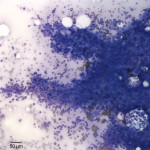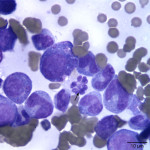Bone marrow aspirate from a cat
Case information
Bone marrow aspirates from a 12 year old domestic medium-hair cat were submitted to the Clinical Pathology Laboratory in the Animal Health Diagnostic Center for cytologic evaluation. The cat had a history of persistent inappetance and fever. A progressive non-regenerative anemia was documented by the veterinarian. An abdominal ultrasound examination done 2 days prior to the aspirate revealed mild hepatomegaly and a mildly enlarged hypoechoic spleen (borderline splenomegaly). Fine-needle aspirates of both organs were performed and slides were prepared and submitted to our laboratory for cytologic evaluation. The examined Wright’s-stained smears of liver and spleen revealed mild lipid accumulation (mostly microvesicular) and extramedullary hematopoiesis (myeloid origin cells), respectively. Hemogram results provided by the veterinarian showed a severe non-regenerative anemia (Hct = 17%, reference interval, 31-48%) and marked thrombocytopenia (30-50 x 103/µL estimate, reference interval, 195-624 x 103/µL). Neutrophils were within reference intervals (7.1 x 103/µL, reference interval, 2.3-11.6 x 103/µL) but displayed moderate toxic change. Serologic testing was positive for antibodies against feline immunodeficiency virus (FIV), but a feline leukemia virus (FeLV) antigen test was negative.
Wright’s-stained smears of the bone marrow aspirate were highly cellular (Figure 1) and all cell lineages (megakaryocytes, myeloid, and erythroid) were present. Megakaryocytes were numerous and both mature and immature forms were seen. Myeloid and erythroid maturation was complete in both cell lines, although the myeloid series dominated (myeloid to erythroid ratio of 6:1; increased = myeloid hyperplasia). There were expanded numbers of monocytic precursors. Low numbers of small lymphocytes (8%) and plasma cells (<1%) were also present. Iron was not identified in the marrow in Prussian blue-stained smears (a normal finding in marrow from cats).
Consider the cytologic description and the representative photomicrographs of the bone marrow below and answer the following questions.
- Identify the cells indicated by the arrows in Figure 2 and Figure 3. Are they normal in appearance?
- Based on the clinical presentation, history, and laboratory data, what is your top differential diagnosis for the hematologic abnormalities described in this cat?
 |
 |
 |
Answer on next page
